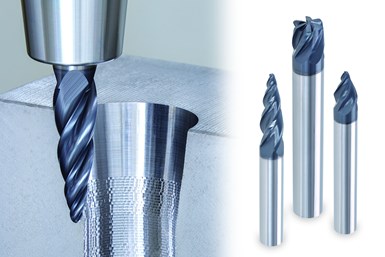Tungaloy Expands Line of Barrel-Shaped End Mills
The new SolidMeister barrel end mills are efficient tools for complex 3D-surfacing operations used in mold making, orthopedic implants and the machining of other freeform surfaces.
Share





Tungaloy introduces eight new barrel-shaped, solid-carbide end mills to its SolidMeister series.
The SolidMeister series offers a range of high-performance, solid-carbide, square-shoulder end mills, ball-nose end mills and high-feed cutters to provide solutions for rough to finish machining in any type of material, with high productivity and extended tool life.
New SolidMeister barrel end mills are efficient tools for complex 3D-surfacing operations used in mold making, orthopedic implants and the machining of gas-turbine blades and other freeform surfaces in the aerospace and energy industries. The end mills incorporate a cutting edge that is actually the segment of a large-diameter arc. Since the shape of the cutting edge resembles a barrel profile, the tool became known as barrel end mills. The large arc segment can significantly increase the stepover distances without degradation of the surface finish parameters, which means that the number of passes and machining time can be reduced.
The barrel end mills come in three different cutting-edge profiles and features: the long-edge version features a large-radius cutting edge of 80 or 90 mm (3.150" or 3.543") and is suited for semi-rough to semi-finish machining; the short-edge version incorporates an even larger cutting edge radius of 250 mm (9.843") lending itself to machining high-precision, straight-walled pockets and curved surfaces; and the lens-shaped version has a barrel-shape cutting edge on its end surface that is useful for machining details perpendicular to the spindle, such as the narrow channels of a tire-mold surface.
The barrel end mills are available in AH710, a wear-resistant, PVD-coated grade that provide the tools with extended tool life and predictability in most material groups.
Related Content
-
High-Feed Machining Dominates Cutting Tool Event
At its New Product Rollout, Ingersoll showcased a number of options for high-feed machining, demonstrating the strategy’s growing footprint in the industry.
-
Finding the Right Tools for a Turning Shop
Xcelicut is a startup shop that has grown thanks to the right machines, cutting tools, grants and other resources.
-
How to Mitigate Chatter to Boost Machining Rates
There are usually better solutions to chatter than just reducing the feed rate. Through vibration analysis, the chatter problem can be solved, enabling much higher metal removal rates, better quality and longer tool life.

























